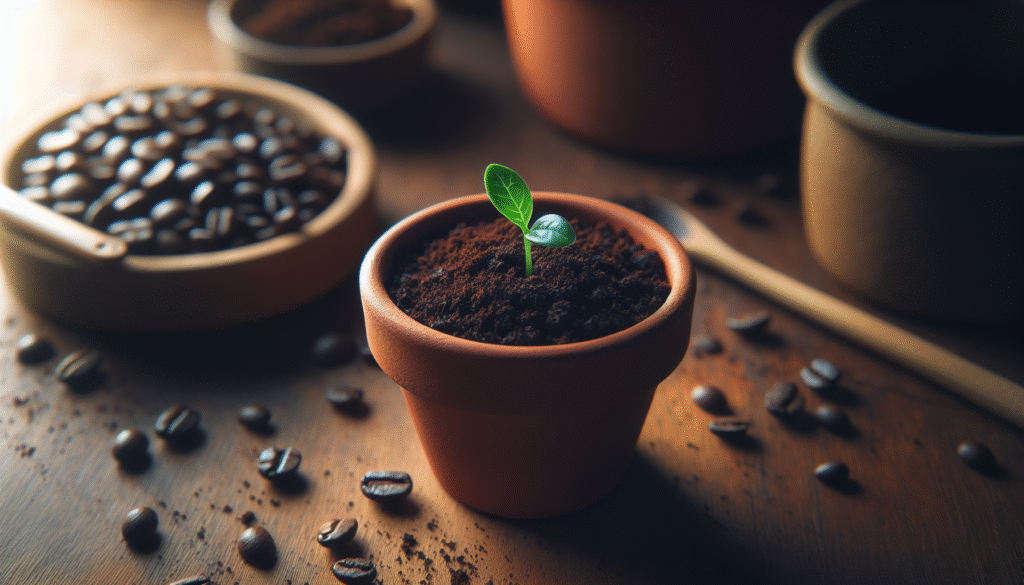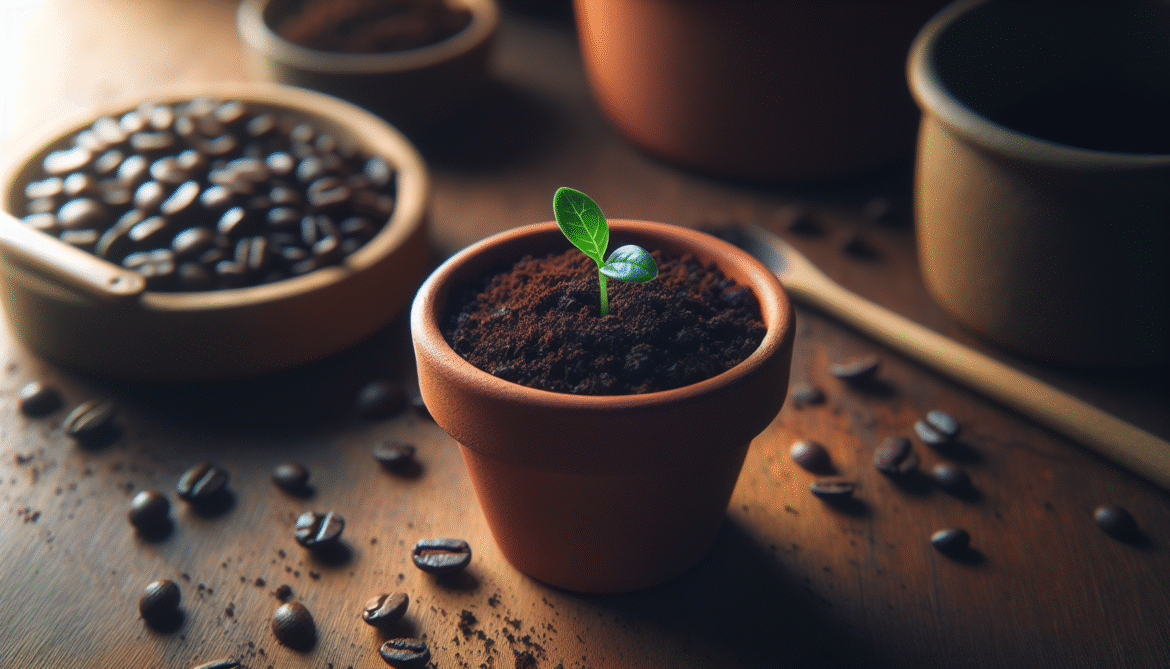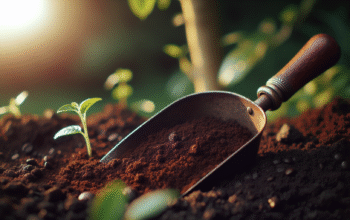Did you know that the coffee grounds left in your filter can become a useful resource for your garden?

Which Plants Like Used Coffee Grounds
You might be surprised by how many plants can benefit from used coffee grounds when you use them correctly. This section gives you an overview of the kinds of plants that generally respond well to grounds and how they respond.
Quick overview of plants that generally like coffee grounds
You’ll find that acid-loving ornamentals, certain shrubs, many container plants, and some vegetables appreciate the nutrients and soil improvements coffee grounds can bring. At the same time, some plants don’t react well to direct, heavy applications, so moderation and correct application matter.
How used coffee grounds affect soil chemistry
Understanding how used coffee grounds change soil chemistry will help you use them safely and effectively. Grounds affect nutrients, acidity, texture, and microbial activity, so you can tailor application to your plants’ needs.
Nutrient content and what it supplies
Used coffee grounds contain small amounts of nitrogen, potassium, phosphorus, and other micronutrients. They’re not a complete fertilizer, but they supply a slow-release source of nitrogen and organic matter that can help soil fertility over time.
pH considerations — acidity myths and realities
Used coffee grounds are often closer to neutral in pH than you might expect because brewing removes much of the acidity. While fresh grounds can be acidic, brewed grounds typically have a pH near neutral, so they’re unlikely to dramatically acidify your soil unless you apply them in very large quantities. Still, they are often recommended for acid-loving plants because of their reputation and the subtle benefits they provide.
Physical effects on soil structure
Coffee grounds add organic matter that improves soil structure, increases water retention in sandy soil, and promotes drainage and aeration in heavier soils. They also encourage beneficial microbial activity and can help earthworm populations, which improve soil tilth.
Which plants benefit from used coffee grounds
Here’s a practical list so you can quickly see which plants are most likely to benefit. Use this as a starting point and adjust based on your soil tests and plant performance.
| Plants that like coffee grounds | Why they benefit | Notes/How to apply |
|---|---|---|
| Blueberries | Prefer acidic, organic soils and benefit from added organic matter | Use grounds mixed into topsoil or compost; avoid heavy, repeated applications |
| Azaleas & Rhododendrons | Acid-loving shrubs that like organic mulch | Lightly incorporate into mulch or compost |
| Hydrangeas | May enjoy organic matter; limited pH effects may slightly influence color | Use in compost or as light topdressing; not a reliable method for color change alone |
| Camellias & Gardenias | Prefer slightly acidic, well-draining soil | Use mixed into potting soil or compost |
| Hollies | Thrive in enriched, organic, slightly acidic soils | Apply as part of an organic mulch or compost |
| Ferns | Like humus-rich, moist soil environments | Mix with potting mix or topdress lightly |
| Tomatoes (moderately) | Benefit from increased nitrogen and organic matter | Use composted grounds or dilute coffee “tea”; avoid direct heavy sprays on roots |
| Peppers (moderately) | Respond to nutrients and improved soil structure | Prefer grounds composted or well-mixed into soil |
| Houseplants (many types) | Benefit when mixed in small amounts into potting mix | Use sparingly to avoid drainage issues |
| Worms (not a plant, but helpful) | Coffee grounds attract earthworms and feed microbes | Add to compost or sprinkle thinly in garden beds |
Plants that tolerate coffee grounds
You’ll find many plants tolerate small amounts of coffee grounds mixed into compost or soil. Most perennials, shrubs, and trees will show no harm from light, infrequent applications when grounds are well mixed.
Plants that tend to dislike heavy or direct applications
Bulb plants (like tulips and daffodils), many seedlings, and some succulents and cacti can be sensitive to high levels of organic nitrogen during growth or to moisture-retaining layers that cause rot. For these, use grounds very sparingly or only as composted material.
Acid-loving ornamentals: best matches for coffee grounds
These plants are the classic examples people think of for coffee grounds use. They prefer slightly acidic, organic soils, and they usually respond positively to the added organic matter.
Blueberries
Blueberries thrive in acidic, well-draining soil rich in organic matter. You can mix used grounds into the top few inches of soil or add them to compost that you later apply around the root zone.
Azaleas and rhododendrons
Azaleas and rhododendrons appreciate soil that remains moist and rich in humus. Use grounds as part of a mulch layer or mix them with leaf mold or pine needles to maintain acidity and moisture.
Hydrangeas
Hydrangeas won’t necessarily change color from coffee grounds alone, but they benefit from the organic matter and improved drainage you get when you use grounds thoughtfully. Mix grounds into compost or use as a thin mulch under shrubs.
Vegetables: when to use coffee grounds for edibles
You can use coffee grounds for many vegetable crops, but the method matters. Composted grounds are safer and more predictable for vegetables than raw, thick layers of fresh grounds.
Tomatoes and peppers
Tomatoes and peppers often benefit from the improved soil structure and slow nitrogen release from composted grounds. Avoid piling fresh grounds around stems; instead, mix grounds into compost or soil several weeks before planting.
Root vegetables and seedlings
Be cautious with seedlings and root crops like carrots and radishes. Fresh coffee grounds can inhibit germination if applied in a thick layer. Use composted grounds or work small amounts into the soil well ahead of sowing.
Brassicas and leafy greens
Brassicas (cabbage, kale) and leafy greens may respond to the nitrogen content in grounds but need balanced nutrients. Use composted grounds mixed with balanced organic fertilizer rather than heavy direct applications.
Herbs: which herbs like coffee grounds
Herbs have varied preferences, and coffee grounds should be applied based on each herb’s needs.
Basil, mint, and parsley
Basil and parsley appreciate fertile, humus-rich soils and can benefit from composted coffee grounds. Mint tolerates a range of conditions but can become overly vigorous with rich soil — watch for runaway growth.
Mediterranean herbs (rosemary, thyme, oregano)
These herbs prefer lean, well-draining soils and don’t like excessive organic matter that retains moisture. Avoid heavy use of coffee grounds with rosemary, thyme, and oregano; if you use them, do so in compost at low rates.

Houseplants and container gardening
Using coffee grounds with houseplants and container gardens requires extra care because containers have limited drainage and root space.
Potting mix inclusion and potting practices
You can mix small amounts of coffee grounds into potting mix (no more than 10% by volume) to add organic matter. Too much can compact and reduce aeration, causing root problems.
Topdressing and watering with coffee “tea”
A light topdressing of composted grounds works well for many houseplants, and diluted coffee “tea” can be used occasionally for watering if your plants tolerate it. Always monitor for mold or changes in plant health.
How to apply used coffee grounds
The application method determines whether you get benefits or problems. Here are several effective ways to use grounds.
Composting coffee grounds (recommended)
Composting used grounds is the safest and most versatile approach, because composting balances carbon and nitrogen and neutralizes any compounds that might inhibit seedlings. Mix grounds with brown materials (leaves, straw, shredded paper) and allow the pile to break down fully before use.
Direct application to soil (lightly)
You can sprinkle a thin layer of used, dry grounds around plant bases, but don’t apply a thick layer. A thin layer (less than 1/4 inch) that’s mixed lightly into the topsoil will help without creating a barrier that repels water or harbors mold.
Making coffee “tea” (liquid feed)
To make coffee “tea,” steep used coffee grounds in water for 24–48 hours and strain. Use the liquid to water plants that like a mild nutrient boost, but dilute if it seems strong. This method lets you apply nutrients without altering soil texture.
Mulching with grounds
Grounds can be part of a mulch blend but should be mixed with coarser materials (wood chips, shredded bark) to maintain airflow and drainage. Avoid using pure grounds as mulch, since they can compact and reduce oxygen around roots.
Burying or incorporating into soil
You can till or dig grounds into garden beds, but do it moderately and not directly into planting holes for seedlings. Mixing them into the soil ahead of planting gives microbes time to process the organic matter.
How much coffee grounds to use and how often
Managing quantity and frequency will keep your plants healthy and your soil balanced.
General application guidelines
Use small amounts frequently rather than large amounts at once. For most garden uses, apply no more than a thin sprinkling or incorporate up to 10–20% coffee grounds by volume into compost or potting mixes.
Vegetable and annual guidelines
For vegetables, add grounds to compost and mix that compost into soil at a rate of 10–20% of the total compost blend. Use brewed grounds sparingly around crop areas and avoid heavy applications near seedlings.
Shrub, tree, and perennial guidelines
Apply composted grounds as part of a mulch or soil amendment around established shrubs and trees. Lightly mix into topsoil and avoid piling up close to trunks to prevent rot.
| Use case | Recommended form | Typical rate |
|---|---|---|
| Composting | Fresh or used grounds | Up to 30% of green material portion; balance with browns |
| Container plants | Composted or dried grounds | Up to 10% of potting mix by volume |
| Mulch/topdressing | Composted and mixed with coarse mulch | Thin layer (≤ 1/4 inch) mixed into topsoil |
| Direct garden beds | Composted grounds mixed into soil | 10–20% of amendment volume |
| Coffee “tea” | Steeped used grounds diluted with water | Use occasionally, monitor plant response |
Potential problems and how to avoid them
If you use too much or use grounds improperly, you can cause issues. Knowing the common problems helps you prevent them.
Mold and fungal growth
If you apply thick layers of moist grounds, you may see white mold or fungal growth. This usually isn’t harmful and will break down naturally, but if it concerns you, mix grounds into compost or soil rather than leaving thick surface layers.
Slugs and pests
Grounds can attract or repel pests depending on conditions. They sometimes draw slugs and snails if used as a moist layer; if that becomes a problem, use grounds in compost or dry them before application.
Seed germination inhibition (allelopathy concerns)
Fresh coffee grounds may inhibit seed germination for some species if applied in large amounts. Don’t use thick layers on seedbeds, and avoid adding fresh grounds to soil right before sowing small-seeded crops.
Nitrogen imbalance and over-fertilization
Because grounds add nitrogen, too much can cause lush foliage at the expense of flowers and fruit or can burn delicate roots. Use composted grounds for a more stable nutrient release and avoid repeated heavy applications.
Contaminants and source considerations
If you’re using grounds from flavored coffees, instant mixes, or grounds contaminated with additives, consider composting to break down any unwanted compounds. If you grill or oil coffee grounds as waste, avoid garden use due to residues.
Benefits beyond nutrients
Coffee grounds do more than feed plants; they improve the ecosystem in ways that help your garden flourish.
Improved soil structure and moisture retention
As grounds break down, they add humus that helps sandy soils retain moisture and improves drainage in clay soils. This makes root growth easier and helps plants tolerate dry spells.
Encouraging beneficial organisms and earthworms
Coffee grounds attract earthworms and increase microbial activity, which enhances nutrient cycling and soil health. Strong microbial communities make nutrients more available to plant roots.
Reducing landfill waste and saving resources
By reusing grounds, you cut waste and reduce the need for synthetic soil conditioners. This is a small but helpful step toward more sustainable gardening.
Best practices and practical recipes
Here are concrete, user-friendly recipes and mixes you can use to apply coffee grounds effectively.
Simple compost mix with coffee grounds
Mix used coffee grounds with brown materials at roughly a 1:2 volume ratio (grounds:browns). Turn regularly and maintain moisture; compost should heat up and break down in weeks to months depending on conditions.
Quick potting mix amendment for houseplants
Combine:
- 8 parts potting soil
- 1 part composted coffee grounds
- 1 part perlite or coarse sand
This adds organic matter without sacrificing drainage.
Coffee “tea” recipe
- Put 2 cups of used coffee grounds in 5 gallons of water.
- Let steep for 24–48 hours, then strain.
- Dilute further if needed and use to water acid-loving plants occasionally.
Mulch blend recipe
Combine:
- 1 part dried coffee grounds
- 3 parts shredded bark or wood chips
- 1 part leaf mold
Spread thinly and mix into the top inch of soil.
Monitoring and troubleshooting
When you introduce coffee grounds into your garden, keep an eye on plant responses and soil condition.
Look for signs of nutrient imbalance
Yellowing leaves (other than normal seasonal changes), stunted growth, or poor flowering can indicate nutrient imbalances. If you suspect excess nitrogen, reduce or stop adding grounds and use a balanced organic fertilizer if needed.
Watch for excess moisture and mold
If potted plants show mold on the soil surface or a sour smell, reduce watering and remove the moldy layer; switch to composted grounds next time. For garden beds, mix grounds into the soil instead of leaving them matted on the surface.
Test soil pH occasionally
If you consistently apply coffee grounds in large amounts and grow pH-sensitive plants, check soil pH once or twice a year. Most gardeners will find little change from normal use, but testing removes uncertainty.
Frequently asked questions (FAQ)
These short Q&As address common concerns you’ll likely encounter.
Can I use fresh (unbrewed) coffee grounds in the garden?
You can, but fresh grounds are more acidic and can be stronger in flavor compounds that may inhibit seed germination. Composted or used grounds are usually safer and more predictable.
Will coffee grounds make my soil acidic enough to change hydrangea color?
Not reliably. Used coffee grounds have a limited, slow effect on pH, and changing hydrangea color usually requires deliberate pH amendments like aluminum sulfate for blue tones. Grounds can contribute organic matter that supports overall plant health.
Are coffee grounds safe around pets?
Used coffee grounds can contain residual caffeine which is toxic to pets in very large amounts. Keep pets from eating large quantities of grounds, and apply grounds in places where pets won’t ingest them.
Do coffee grounds attract pests?
Moist, fresh grounds can attract pests like slugs or sometimes rodents, while dry, composted grounds are less attractive. Use dried or composted grounds, and avoid thick, wet surface layers.
How long do coffee grounds take to break down in soil?
When mixed into compost, grounds break down in weeks to months depending on pile conditions. In garden soil, decomposition times vary with temperature, moisture, and microbial activity.
Summary and final tips
You can turn your daily coffee habit into a garden asset by using used coffee grounds thoughtfully and in moderation. Favor composting and mixing grounds into soil rather than piling them on the surface, and tailor application to the needs of each plant group.
Final practical tips:
- Compost most grounds before use for best results and fewer risks.
- Use thin layers or low-percentage mixes in potting soil to avoid compaction.
- Favor acid-loving ornamentals, many shrubs, and certain vegetables, but be cautious with seedlings, bulbs, and drought-loving Mediterranean herbs.
- Monitor plant response and soil pH when making changes.
If you start with small, well-mixed applications and pay attention to how your plants respond, coffee grounds can be a helpful, sustainable addition to your gardening routine.



